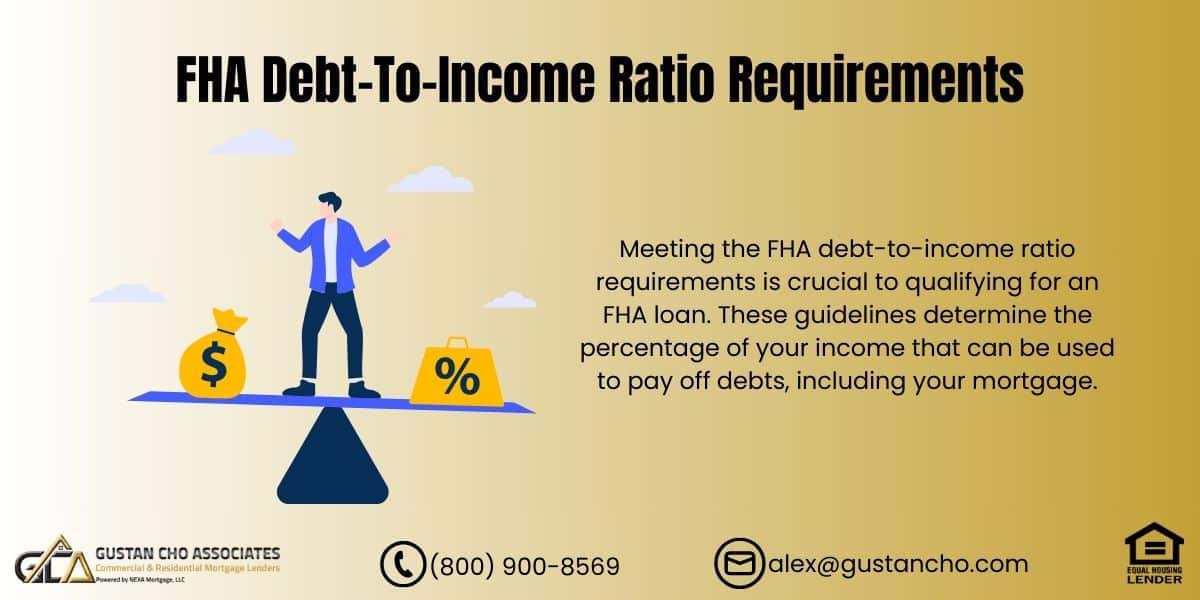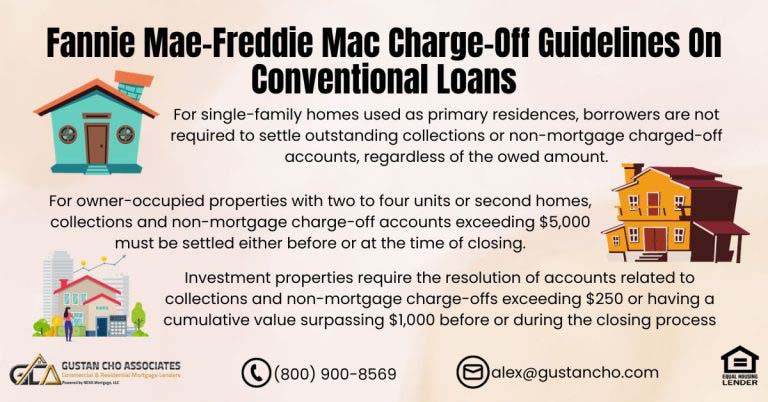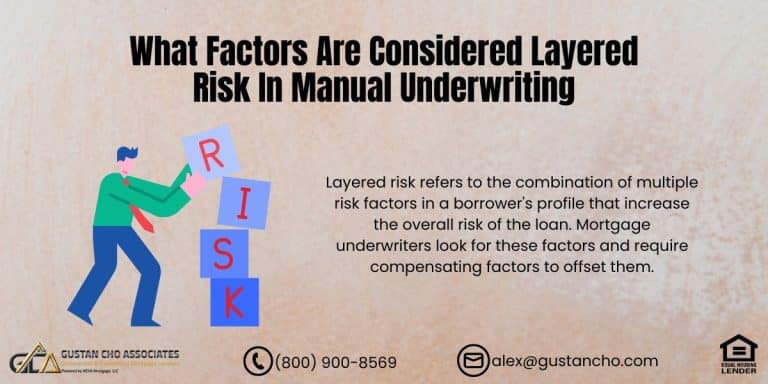FHA Debt-To-Income Ratio Requirements: What You Need to Know
If you’re applying for an FHA loan, one of the most important things lenders look at is your debt-to-income ratio (DTI). Simply, this tells lenders how much of your income is already going toward monthly debts, including your future mortgage.
If your DTI is too high, you may not qualify for a loan—unless you’re working with a lender that has no overlays, like Gustan Cho Associates.
In this updated guide, we break down everything you need to know about FHA debt-to-income ratio requirements, how they work, and how to get approved even if other lenders have turned you down.
What Is a Debt-to-Income Ratio?
What is a debt-to-income ratio? It’s a way to see how much money you owe each month compared to how much you earn. You can figure it out with a simple calculation:
DTI = (Total Monthly Debt Payments ÷ Gross Monthly Income) x 100 For FHA loans, there are two important types of debt-to-income ratios:
- Front-End DTI: This only considers your housing costs, including your monthly mortgage, property taxes, and insurance.
- Back-End DTI: This includes your housing costs plus all your other monthly debts, like credit cards, car loans, and student loans.
Understanding these FHA debt-to-income ratio requirements can help you know how much money you can borrow.
Qualify for a 3.5% down payment FHA loan
Apply Online And Get recommendations From Loan Experts
FHA Debt-To-Income Ratio Requirements
The FHA debt-to-income ratio requirements dictate how much money you can borrow for a home loan relative to your income. There are two key components to consider. The Front-End DTI allows you to allocate up to 46.9% of your income towards housing costs, including your mortgage and property taxes. Meanwhile, the Back-End DTI permits you to use as much as 56.9% of your total income to cover all monthly debts, including car loans and credit card payments.
Just keep in mind this key point! These limits only kick in if you get an “Approve/Eligible” from the Automated Underwriting System (AUS), and your credit score has to be at least 620 or higher.
If your credit score is below 620, you can only have a debt-to-income ratio of 43% unless you have other good reasons that show you can handle the loan.
How Lenders Calculate Your DTI
Here’s what lenders count when calculating your FHA debt-to-income ratio requirements:
Included in DTI:
- Mortgage payment (PITI)
- Auto loans
- Student loans
- Credit cards (minimum payments)
- Personal loans
Not included in DTI:
- Utilities
- Cell phone bills
- Groceries and gas
- Childcare (unless court-ordered)
To calculate:
- Add your monthly housing payment (PITI)
- Add the minimum payments for all your other debts
- Calculate the total and then divide it by your gross monthly income
FHA Loan Requirements Based on Credit Score
Your credit score plays a significant role in determining how high your debt-to-income (DTI) ratio can be. If your credit score is 580 or higher, you can qualify for a loan with a down payment of just 3.5%. However, if your score falls between 500 and 579, you can still be eligible, but you will need to make a larger down payment of 10%.
If your score is under 620, most lenders require your back-end DTI to be under 43%, even though HUD allows higher.
This is where lender overlays come in—and where Gustan Cho Associates makes a big difference.
What Are Lender Overlays?
Lender overlays are extra rules that lenders add on top of FHA guidelines. For example, while the FHA says you can go up to 56.9% DTI with a 620+ score, many lenders will cap you at 43% or 45%.
Why do they do this? Because lenders don’t want to risk funding loans that might not sell on the secondary market. But at Gustan Cho Associates, we have zero overlays on FHA debt-to-income ratio requirements. We go strictly by what FHA allows.
Manual Underwriting and DTI Caps
When dealing with a manually underwritten loan, the debt-to-income (DTI) caps are stricter than those with automated underwriting system (AUS) approval. Specifically, for a manual underwrite, the requirements are set at a maximum of 31% for the front-end DTI and 43% for the back-end DTI without any compensating factors. If there is one compensating factor, such as cash reserves, the limits increase to 37% for the front end and 47% for the back end.
Additionally, if two compensating factors are present, such as a strong rent history combined with reserves, the allowable DTI caps are 40% for the front-end and 50% for the back-end.
Manual underwriting is common if you have a recent Chapter 13 bankruptcy or don’t have a credit score.
Real Example: Denied at 45% DTI? Here’s Why
Let’s say you have a 640 credit score and a 52% DTI. FHA guidelines say you qualify, right?
Yes, but your lender says no. Why? They have lender overlays that cap DTI at 45%.
That’s why many borrowers come to us after being denied elsewhere. At Gustan Cho Associates, we don’t impose overlays. We approve borrowers that others turn down.
Take First Step Toward Qualify For FHA Loan
Apply Online And Get recommendations From Loan Experts
FHA vs. Conventional DTI Guidelines
Loan Type Max Back-End DTI Front-End DTI
| Loan Type | Max Back-End DTI | Front-End DTI |
|---|---|---|
| FHA (AUS) | 56.9% | 46.9% |
| FHA (Manual) | 50% max | 40% max |
| Conventional | 50% (with 680+ score) | N/A |
Conventional loans generally require elevated credit scores and a reduced debt-to-income ratio for approval through the Automated Underwriting System (AUS).FHA loans offer more leniency but are primarily influenced by the lender’s specific guidelines.
Tips to Qualify with High DTI
- Raise Your Credit Score: The higher your score, the better your AUS findings.
- Reduce Your Debt: Pay off credit cards or car loans before applying.
- Add a Co-Borrower: Their income helps lower the overall DTI.
- Get Compensating Factors: Like large down payments or cash reserves.
- Choose the Right Lender: Work with one that has no overlays on FHA debt-to-income ratio requirements.
Why Choose Gustan Cho Associates?
- There are no lender overlays for FHA, VA, USDA, and Conventional loans.
- DTI up to 56.9% allowed (if AUS approves it)
- Experts in manual underwriting and tough loan files
- Licensed in 50 states, including DC and Puerto Rico
- Available 7 days a week, including evenings and holidays
If you’ve been turned down due to high DTI, give us a call or apply online. We close loans others can’t.
Take the First Step
Want to know if you meet the FHA debt-to-income ratio requirements? We make it simple to get in touch with us. You can contact us by emailing alex@gustancho.com or by calling 800-900-8569. If you’re looking for a faster reply, don’t hesitate to text us at any time. Furthermore, you can follow the link below to receive pre-approval and consult with a loan expert.
Frequently Asked Questions About FHA Debt-to-Income Ratio Requirements:
Q: What are FHA Debt-to-Income Ratio Requirements?
A: FHA debt-to-income ratio requirements show how much of your monthly income you can use to pay for your mortgage and other debts. To qualify, you may need to keep your DTI below 56.9% if your credit score is 620 or higher.
Q: How do I Figure Out My Debt-to-Income Ratio for an FHA Loan?
A: To find your debt-to-income (DTI) ratio, start by adding your monthly housing costs, including your mortgage, taxes, and insurance. Next, add all your other monthly debt payments, such as credit cards and car loans. Then, divide that total by your gross monthly income. This will show you if you meet the FHA’s debt-to-income requirements.
Q: What is the Highest DTI Allowed for an FHA Loan?
A: If your credit score is 620 or higher and you get AUS approval, FHA allows up to 46.9% for housing alone (front-end) and 56.9% for all debts combined (back-end). These are the maximum FHA debt-to-income ratio requirements.
Q: Can I Still Qualify if My Credit Score is Under 620?
A: Yes, but your DTI usually has to stay under 43% unless you have strong compensating factors. Some lenders have even stricter rules, so working with a lender who follows only FHA debt-to-income ratio requirements—like Gustan Cho Associates—can help.
Q: Why Did Another Lender Deny Me Even Though I Met FHA Guidelines?
A: Most likely, that lender added their own rules called overlays. They may cap DTI lower than what FHA allows. At Gustan Cho Associates, we follow FHA debt-to-income ratio requirements without any overlays.
Q: What’s the Difference Between Front-End and Back-End DTI?
A: Front-end DTI only looks at your housing costs. Back-end DTI includes housing, credit cards, car loans, and other monthly debts. Both are checked when reviewing FHA debt-to-income ratio requirements.
Q: What if I Don’t Have a Credit Score or Just Came Out of Bankruptcy?
A: Your loan may need manual underwriting. In that case, FHA debt-to-income ratio requirements are lower—often between 31% and 50%, depending on your financial strengths, such as cash reserves or rental history.
Q: Are FHA loans more flexible than conventional loans?
Yes, FHA loans usually allow higher DTI and lower credit scores. Conventional loans usually cap DTI at 45–50%, but FHA debt-to-income ratio requirements go up to 56.9% with AUS approval.
Q: What Can I do if My DTI is Too High?
A: Try paying down some debt, improving your credit score, adding a co-borrower, or working with a lender that allows higher DTI. Gustan Cho Associates follows only FHA debt-to-income ratio requirements—there are no stricter rules.
Q: How do I Apply if I Meet FHA Debt-to-Income Ratio Requirements?
A: You can call, email, or apply online with Gustan Cho Associates. We help you get pre-approved, even if other lenders say no due to DTI or credit issues.
This blog on FHA debt-to-income ratio requirements was updated on June 30th, 2025.
Take First Step Toward Making Your Dream A Reality
Apply Online And Get recommendations From Loan Experts










